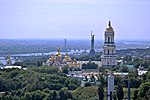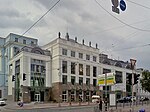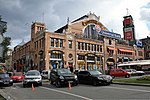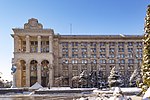Kyiv City Council

Kyiv City Council (Ukrainian: Київська міська рада, romanized: Kyivska miska rada), also known as Kyivrada (Ukrainian: Київрада), is the city council of Kyiv municipality, the highest representative body of the city community. The members of city council are directly elected by Kyivans and the council is chaired by the Mayor of Kyiv (who is also directly elected in a separate election independent of the council election) or the City Council Secretary (elected among the council members). The deputies are elected for five-year terms.The council meets in a 1950s City Council building constructed in neo-classical Stalinist architectural style on Khreschatyk, the city's main street. The most recent Kyiv local election (including Mayoral elections) took place on 25 October 2020.
Excerpt from the Wikipedia article Kyiv City Council (License: CC BY-SA 3.0, Authors, Images).Kyiv City Council
Khreshchatyk Street, Kyiv Центр
Geographical coordinates (GPS) Address Phone number Website Nearby Places Show on map
Geographical coordinates (GPS)
| Latitude | Longitude |
|---|---|
| N 50.446388888889 ° | E 30.521111111111 ° |
Address
Київська міська державна адміністрація
Khreshchatyk Street 36
01901 Kyiv, Центр
Ukraine
Open on Google Maps










